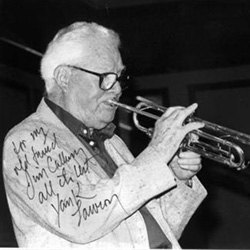This edition of Riverwalk Jazz honors the legacy of Yank Lawson on the occasion of his passing, February 18, 1995. On our show, bandleader Jim Cullum shares his personal memories of Yank Lawson and we hear performances by Yank Lawson and Bob Haggart recorded live on stage at The Landing during our first Riverwalk Jazz production date in February 1990.
Yank Lawson remains one of the all-time great jazz trumpeters; his fire and drive fueled the Bob Crosby, Benny Goodman and Tommy Dorsey Orchestras. Working alongside his friend, the bassist Bob Haggart, he also co-led the all-star jazz ensemble known as The World’s Greatest Jazz Band. ‘The World’s Greatest’ was founded by jazz aficionado Dick Gibson in 1968 at his sixth annual Jazz Party, and was disbanded in 1978, except for occasional revivals by Lawson and/or Haggart.
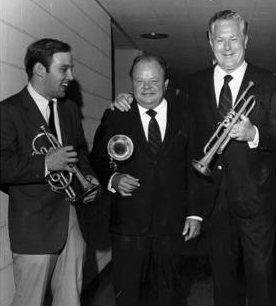
L-R: Jim Cullum, Jr., Billy Butterfield and trumpeter Yank Lawson, cir. 1968. Photo courtesy Jim Cullum Jr.
Jim Cullum recalls: “Yank Lawson was a good friend of my father, and he became my good friend, too. We had many occasions to perform together. When he passed away I flew up to Indianapolis to say goodbye, and I played at his memorial. But I remember the first time I met Yank in 1958, when I was a 17-year-old kid with a pretty bad case of the jazz bug. Yank was a staff musician at NBC at that time, and my father and I had come to New York on a mission to listen to jazz, and he took me around to listen to his musician friends. We heard Jack Teagarden at the Round Table and Gene Krupa at the Metropole. We hung out at Jimmy Ryan’s on 52nd St., and then we spent a long evening, into the wee hours of the morning, listening to Bix Beiderbecke records out at Yank’s place in Massapequa, Long Island. More than 30 years later, in February 1989, Yank came down to The Landing for our very first Riverwalk, Live from The Landing broadcast production, hosted by George Fenneman, who many remember as Groucho Marx’s sidekick on the long-running You Bet Your Life TV series.“
The producers dug deep into the Riverwalk archive to discover these never-before-broadcast performances from the original 1989 session with the two friends, bassist Bob Haggart and trumpeter Yank Lawson, sitting in with Jim and the Band.
.jpg)
Bob Crosby Bob Cats,1935. Yank Lawson and Bob Haggart pictured 2nd from right, back row. Photo courtesy Time-Life Records
In the 1930s the Bob Crosby Band was a hotbed of creativity and Yank Lawson was at the heart of it. A group of brilliant young musicians, head-over-heels in love with early jazz and swing, the Crosby band musicians played off each other’s creative impulses. Bob Haggart ignited the ensemble’s mutual drive with numerous hit tunes, many still popular today, including “What’s New?” and “My Inspiration.” Bob Zurke was a mad genius at the piano. A trio of high-powered players from New Orleans with a strong belief in the ‘real stuff’ were founding members—Ray Bauduc on drums, Eddie Miller on tenor saxophone and Irving Fazola on clarinet. These storied hot jazz players came together at their peak to form the Crosby Band.
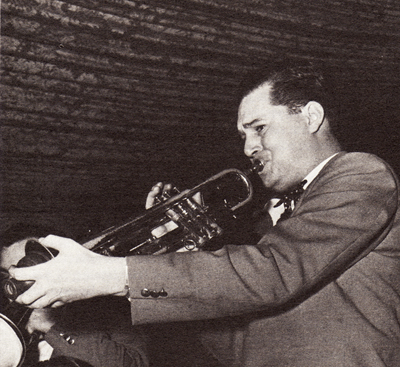
Trumpeter Yank Lawson. Photo courtesy Jim Cullum, Jr.
Jim Cullum says, “The real fire in the band came from Yank’s playing. Yank had more drive than anybody else, and he gave all the bands he played with edge and zing. You can hear it early on the Crosby Band recordings, and later on when he played in the World’s Greatest Jazz Band. It was his biggest contribution, and Yank was very proud of that.”
Bob Crosby band pianist Bob Zurke had a well-earned reputation as a wild man due to his infamous, non-stop drinking, and yet when Zurke sat down at the piano he could be spectacular. Here, fellow band mate Bob Haggart tells the story of how Zurke would show up hung-over everyday for rehearsal. He would be a real mess, and the first thing Zurke demanded was an “eye-opener”—a shot of whiskey, and a Coca-Cola chaser to settle his stomach and turn on his brain. One day, Yank Lawson, Bob Haggart and the rest of the guys decided to play a trick on Zurke. They poured some leftover tea into a shot glass and had it waiting for Zurke. The hung-over piano player walked in feeling shaky and complaining about his head. Zurke gulped the tea (thinking it was whiskey) and immediately swigged the Coca Cola, then wiped his mouth and said, “Thanks, guys, that was good. I really needed that eye-opener.” On this radio show, piano masters Dick Hyman and John Sheridan tackle the very challenging piece Zurke wrote and titled “Eye Opener” in a stunning two-piano version.
Our broadcast tribute to Yank Lawson features several of the best-known Bob Crosby Band classics. “Dogtown Blues” and “South Rampart Street Parade” feature Dick Hyman on piano, Bob Haggart on bass and Yank Lawson on trumpet. Cullum Band reedman Brian Ogilvie pays tribute to Crosby Band tenor saxophonist Eddie Miller with Miller’s original, “Lazy Mood.”
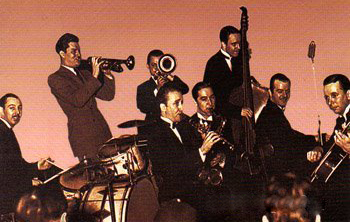
Bob Crosby Bob Cats. Image courtesy musicstorm.org
Western songwriter Billy Hill wrote “Old Spinning Wheel” in 1930. Hill was also the composer of "The Last Roundup," "Wagon Wheels" and a hit for Louis Armstrong, “There’s a Cabin in the Pines.” As heard on this broadcast, “Old Spinning Wheel” and “March Of The Bob Cats” (based on “Maryland, My Maryland”) are two examples of harmonically simple folk-like songs the Bob Crosby Band musicians liked to play. Jim Cullum says, “Yank had a great ability to take simple tunes, apply his ability to improvise, and wind up creating new melodies on them, transforming them into jazz classics.”
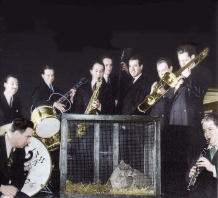
Bob Crosby Bob Cats
Bandleader Cullum continues, “In my view, the Bob Crosby Band was one of the great jazz ensembles of the era. They set a standard, and inspired bands like ours, which have followed in their footsteps. In addition to creating their own original tunes, many of which became jazz standards, they admired George Gershwin and adapted Gershwin’s “Summertime” as their theme song. They used it as the opening number on all their radio shows.”
On this radio show Yank Lawson says, “George Gershwin used to enjoy the Crosby band. He’d often come in to the Lexington Hotel in New York to hear us play and we got friendly with him. He gave us permission to use “Summertime” as a theme, and it was a good choice for us.”
Yank frequently said that a high point of his career was a phone call he received from Louis Armstrong asking him to be a part of the Satchmo musical biography recording session in 1957. Of all the jazz trumpeters Louis Armstrong had available to him at the peak of his career, Armstrong chose Yank Lawson to take King Oliver’s part in this major statement of his life’s work. Apparently in Yank’s playing, Armstrong heard the same force he appreciated in King Oliver’s playing—a unique ability to galvanize a group of musicians and burn them into a unified ensemble greater than the sum of their individual talents.
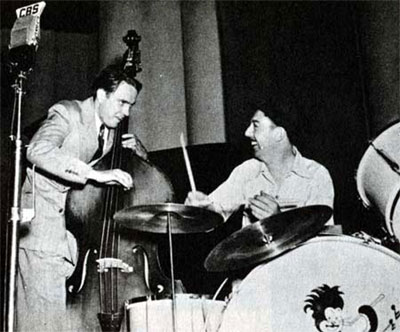
Bob Haggart and Ray Bauduc. Photo courtesy drummerworld
Crosby Band drummer Ray Bauduc had a long association with this week’s guests Yank Lawson and Bob Haggart. Ray didn’t compose music, but he would ‘think up melodies’ and then sing them to Bob Haggart, who wrote out the musical notation. This is how the hot jazz standard “South Rampart Street Parade,” heard here performed by Dick Hyman and Bob Haggart with the Cullum Band, was created. The Crosby Band’s huge hit number “Big Noise from Winnetka” grew out of another Ray Bauduc improvisation; and his tune “Big Crash From China,” also heard on this broadcast, has a melody recalling the great Bix Beiderbecke.
Yank Lawson’s career had a variety of aspects. He started out touring with southwest territory bands in the 1920s. He joined Ben Pollack’s group, and then spent arguably his most creative years with the Bob Crosby Orchestra. Yank left Crosby briefly to join Tommy Dorsey, but it wasn’t long before he was back on the Crosby bandstand having a ball. During the World War II years, when the Crosby Band broke up, Yank went to work for Benny Goodman. In the 1950s Yank Lawson signed on as an NBC staff musician and was sought after for every kind of session work imaginable. Throughout the 1960s, Lawson was a key player in the Tonight Show band. Jim Cullum remembers accompanying Yank to his gig at The Tonight Show in New York and meeting famous jazz stars backstage, including singer Sarah Vaughan.
In 1968 one of Yank’s dreams came true when he formed The World’s Greatest Jazz Band with his friend Bob Haggart. A tune Yank and Bob often played as a duet with The World’s Greatest was Charlie Chaplin’s “Smile.” The two men recreate it in a stunning performance on this radio show.
Jim Cullum says, “Yank Lawson was a great big, gentle guy. He was a handsome man, over six feet tall. He had an enormous enthusiasm for life. As a musician, he had a powerful ability to swing the band, to inspire the musicians, and to set the music on fire. I was lucky to be his friend and to hear him play.”
Photo credit for Home Page: Yank Lawson courtesy Jim Cullum Jr
Text based on Riverwalk Jazz script by Margaret Moos Pick ©1995


